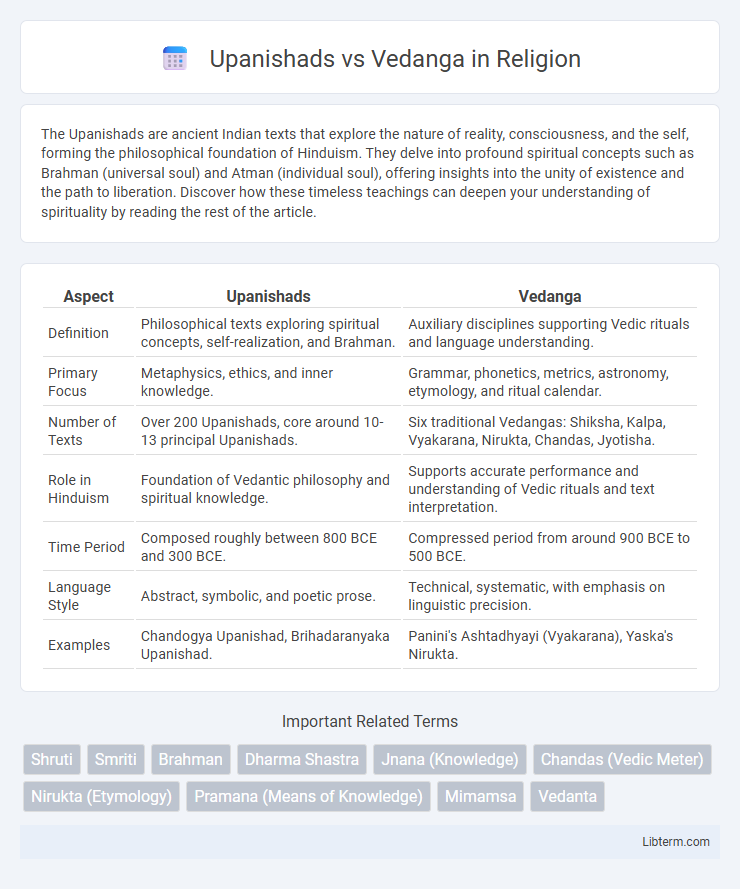The Upanishads are ancient Indian texts that explore the nature of reality, consciousness, and the self, forming the philosophical foundation of Hinduism. They delve into profound spiritual concepts such as Brahman (universal soul) and Atman (individual soul), offering insights into the unity of existence and the path to liberation. Discover how these timeless teachings can deepen your understanding of spirituality by reading the rest of the article.
Table of Comparison
| Aspect | Upanishads | Vedanga |
|---|---|---|
| Definition | Philosophical texts exploring spiritual concepts, self-realization, and Brahman. | Auxiliary disciplines supporting Vedic rituals and language understanding. |
| Primary Focus | Metaphysics, ethics, and inner knowledge. | Grammar, phonetics, metrics, astronomy, etymology, and ritual calendar. |
| Number of Texts | Over 200 Upanishads, core around 10-13 principal Upanishads. | Six traditional Vedangas: Shiksha, Kalpa, Vyakarana, Nirukta, Chandas, Jyotisha. |
| Role in Hinduism | Foundation of Vedantic philosophy and spiritual knowledge. | Supports accurate performance and understanding of Vedic rituals and text interpretation. |
| Time Period | Composed roughly between 800 BCE and 300 BCE. | Compressed period from around 900 BCE to 500 BCE. |
| Language Style | Abstract, symbolic, and poetic prose. | Technical, systematic, with emphasis on linguistic precision. |
| Examples | Chandogya Upanishad, Brihadaranyaka Upanishad. | Panini's Ashtadhyayi (Vyakarana), Yaska's Nirukta. |
Introduction to Upanishads and Vedanga
The Upanishads are a collection of ancient Indian texts that primarily explore philosophical concepts, meditation, and the nature of ultimate reality (Brahman). Vedanga refers to six auxiliary disciplines--Shiksha (phonetics), Kalpa (rituals), Vyakarana (grammar), Nirukta (etymology), Chandas (meter), and Jyotisha (astronomy)--developed to support the proper understanding and use of the Vedas. While the Upanishads delve into metaphysical insights and spiritual knowledge, the Vedangas provide practical tools essential for preserving and interpreting Vedic scriptures.
Historical Background and Origins
The Upanishads, composed between 800 and 500 BCE, represent the culmination of Vedic literature, emphasizing philosophical and spiritual insights into the nature of reality and the self. In contrast, the Vedangas originated earlier as auxiliary disciplines around 1000 BCE, designed to support and preserve the accuracy of Vedic rituals and texts through studies of phonetics, grammar, astrology, and metrics. The historical development of the Upanishads marks a shift from ritualistic practices to introspective wisdom, while the Vedangas focus on the technical foundation essential for correctly interpreting the Vedas.
Philosophical Foundation: Upanishads
The Upanishads establish the core philosophical foundation of Vedic literature by exploring metaphysical concepts such as Brahman (ultimate reality) and Atman (self). They emphasize knowledge (jnana) and meditation as paths to spiritual liberation (moksha), diverging from the ritualistic focus of the Vedangas. This shift marks the transition from external sacrificial rites to inner spiritual inquiry, shaping classical Indian philosophy.
Functional Role: Vedanga in Vedic Tradition
Vedanga serves as the six auxiliary disciplines essential for the correct understanding and application of the Vedas, underpinning the phonetics, grammar, rituals, astronomy, and metrics in Vedic tradition. Unlike the Upanishads, which explore metaphysical knowledge and spiritual philosophy, Vedanga provides practical tools to preserve the accuracy and transmission of Vedic texts. The disciplines--Shiksha, Vyakarana, Chandas, Nirukta, Kalpa, and Jyotisha--ensure rigorous linguistic and ritualistic precision critical to Vedic scholarship and religious practice.
Key Teachings of the Upanishads
The Upanishads emphasize self-realization, the nature of Brahman (universal consciousness), and the unity of Atman (individual soul) with Brahman, forming the philosophical core of Hindu thought. They focus on meditation, ethical living, and knowledge (jnana) as paths to spiritual liberation (moksha), contrasting with the Vedanga, which are auxiliary disciplines supporting the correct understanding and performance of Vedic rituals. The Upanishads reject ritualistic formalism, prioritizing inner wisdom and metaphysical inquiry over external ceremonies.
Structure and Components of Vedanga
Vedanga comprises six auxiliary disciplines--Shiksha (phonetics), Vyakarana (grammar), Chandas (metrics), Nirukta (etymology), Kalpa (ritual instructions), and Jyotisha (astronomy)--designed to support the understanding and proper application of the Vedas. Unlike the Upanishads, which focus on philosophical inquiry and metaphysical knowledge, Vedanga provides practical tools for interpreting Vedic texts through precise linguistic and ritual frameworks. The structured components of Vedanga ensure the preservation, pronunciation, and ritual accuracy essential to Vedic tradition.
Differences in Purpose and Application
Upanishads primarily explore philosophical concepts and spiritual knowledge related to the nature of reality, self, and ultimate truth, forming the core of Vedantic thought. Vedangas serve as auxiliary disciplines focused on the practical aspects of Vedic rituals, including phonetics, grammar, and calendar calculations essential for accurate recitation and ritual performance. While Upanishads aim at metaphysical understanding and liberation (moksha), Vedangas emphasize preserving and applying Vedic texts correctly within religious ceremonies.
Influence on Later Hindu Thought
The Upanishads profoundly shaped later Hindu philosophy by introducing key concepts such as Brahman (ultimate reality) and Atman (soul), which became foundational in Vedanta and other schools. Vedanga, comprising six auxiliary disciplines like phonetics and grammar, primarily supported the accurate interpretation and preservation of Vedic texts, indirectly influencing ritualistic practices. Together, their combined insights ensured the continuity of Vedic knowledge and the development of complex theological and metaphysical doctrines in Hinduism.
Comparative Analysis: Upanishads vs Vedanga
The Upanishads primarily explore metaphysical concepts and spiritual knowledge, forming the philosophical foundation of Hinduism, whereas the Vedangas serve as ancillary disciplines that support the correct understanding and usage of the Vedas through linguistic, phonetic, and ritualistic analyses. Upanishads emphasize inner realization and the nature of Brahman and Atman, while Vedangas focus on practical aspects like grammar (Shiksha and Vyakarana), ritual rites (Kalpa), and astronomy (Jyotisha). The Upanishads influence religious doctrines and meditation practices, contrasting with Vedangas' role in preserving Vedic accuracy and performing rituals effectively.
Conclusion: Lasting Legacies
The Upanishads established profound philosophical foundations that deeply influenced Hindu spirituality and metaphysics, emphasizing the nature of reality and self-realization. Vedanga contributed essential linguistic and ritual tools, such as grammar, phonetics, and astronomy, ensuring the accurate preservation and practice of Vedic traditions. Together, they forged enduring legacies that shaped Indian religious thought and cultural continuity for millennia.
Upanishads Infographic

 libterm.com
libterm.com